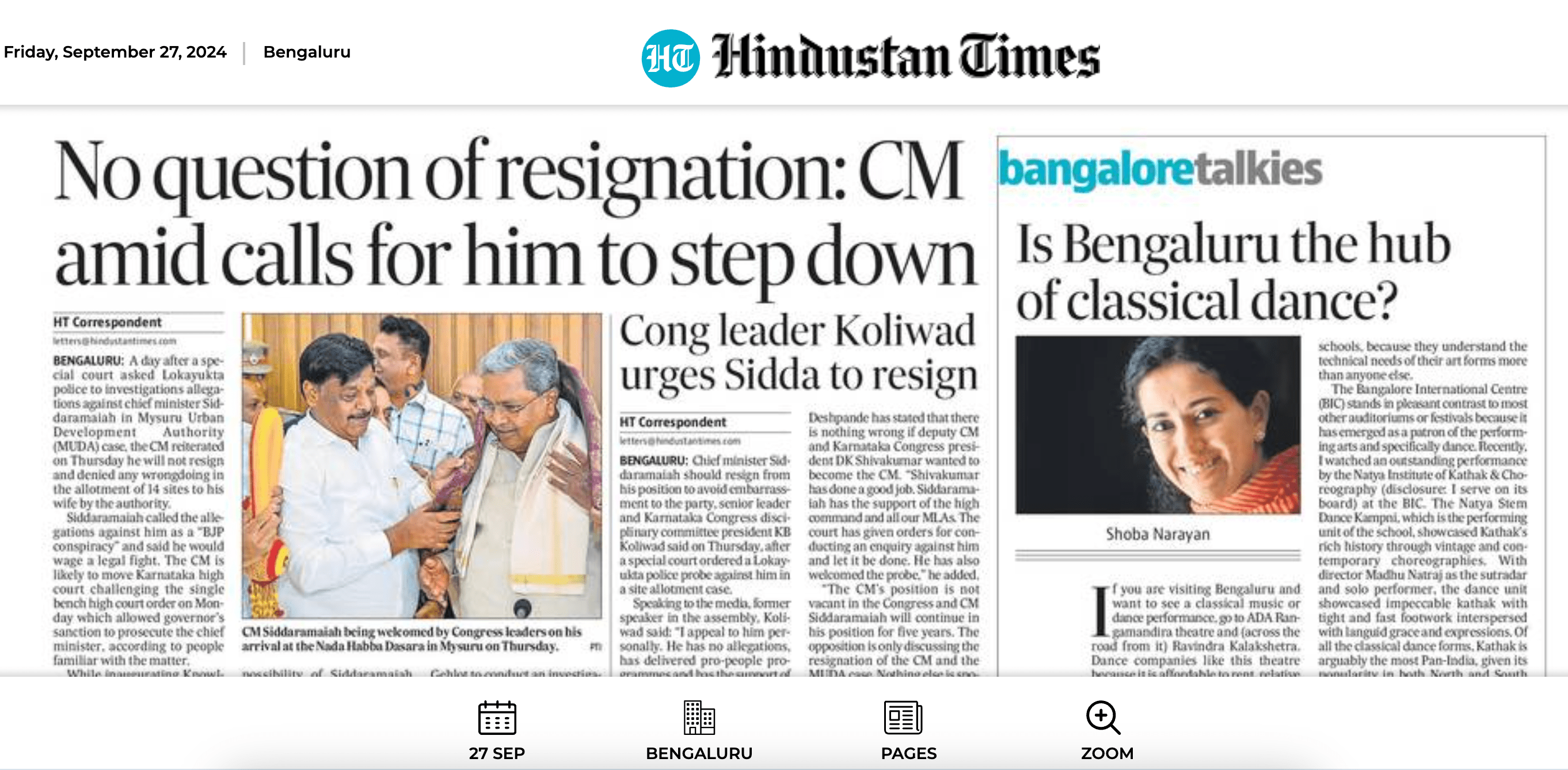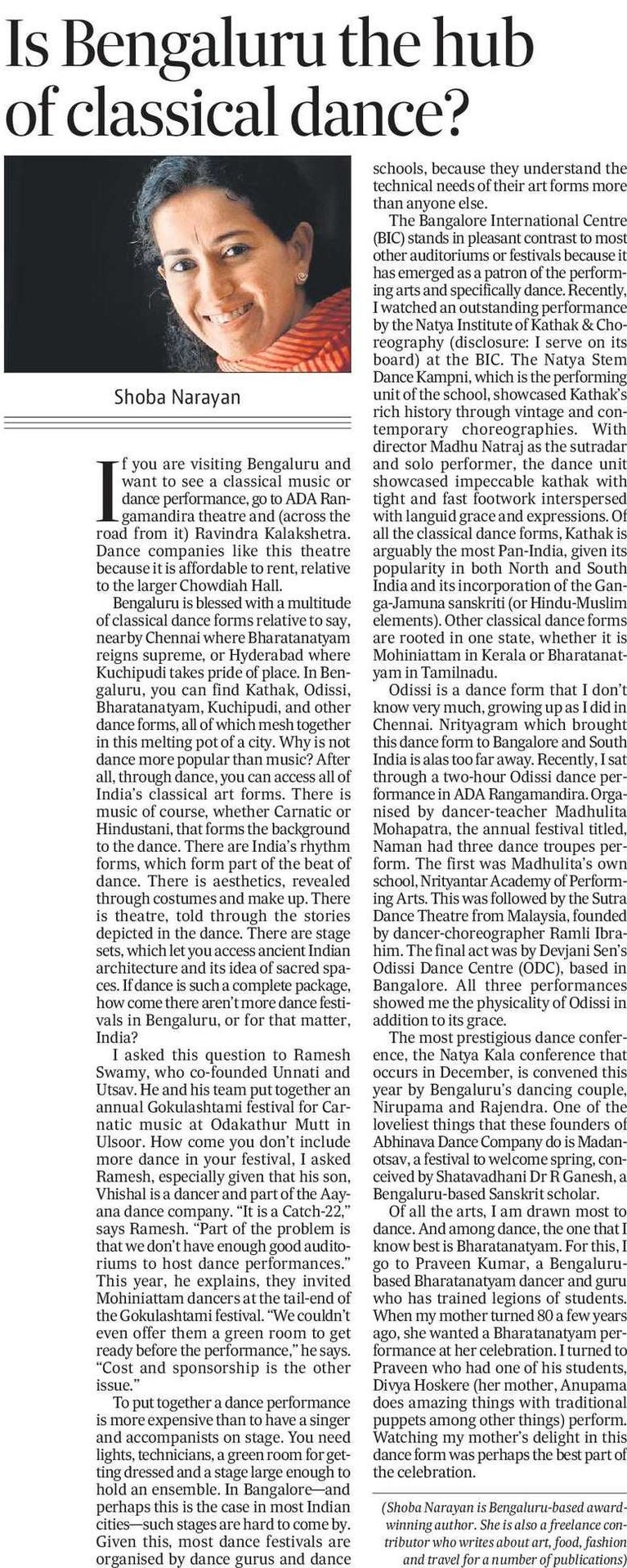If you are visiting Bengaluru and want to see a classical music or dance performance, go to ADA Rangamandira theatre and (across the road from it) Ravindra Kalakshetra. Dance companies like this theatre because it is affordable to rent, relative to the larger Chowdiah Hall.
Bangalore is blessed with a multitude of classical dance forms relative to say, nearby Chennai where Bharatanatyam reigns supreme, or Hyderabad where Kuchipudi takes pride of place. In Bangalore, you can find Kathak, Odissi, Bharatanatyam, Kuchipudi, and other dance forms, all of which mesh together in this melting pot of a city. Why is not dance more popular than music? After all, through dance, you can access all of India’s classical art forms. There is music of course, whether Carnatic or Hindustani, that forms the background to the dance. There are India’s rhythm forms, which form part of the beat of dance. There is aesthetics, revealed through costumes and make up. There is theatre, told through the stories depicted in the dance. There are stage sets, which let you access ancient Indian architecture and its idea of sacred spaces. If dance is such a complete package, how come there aren’t more dance festivals in Bangalore, or for that matter, India?
I asked this question to Ramesh Swamy, who co-founded Unnati and Utsav. He and his team put together an annual Gokulashtami festival for Carnatic music at Odakathur Mutt in Ulsoor. How come you don’t include more dance in your festival, I asked Ramesh, especially given that his son, Vhishal is a dancer and part of the Aayana dance company. “It is a Catch-22,” says Ramesh. “Part of the problem is that we don’t have enough good auditoriums to host dance performances.” This year, he explains, they invited Mohiniattam dancers at the tail-end of the Gokulashtami festival. “We couldn’t even offer them a green room to get ready before the performance,” he says. “Cost and sponsorship is the other issue.”
To put together a dance performance is more expensive than to have a singer and accompanists on stage. You need lights, technicians, a green room for getting dressed and a stage large enough to hold an ensemble. In Bangalore—and perhaps this is the case in most Indian cities—such stages are hard to come by. Given this, most dance festivals are organised by dance gurus and dance schools, because they understand the technical needs of their art forms more than anyone else.
The Bangalore International Centre (BIC) stands in pleasant contrast to most other auditoriums or festivals because it has emerged as a patron of the performing arts and specifically dance. Recently, I watched an outstanding performance by the Natya Institute of Kathak & Choreography (disclosure: I serve on its board) at the BIC. The Natya Stem Dance Kampni, which is the performing unit of the school, showcased Kathak’s rich history through vintage and contemporary choreographies. With director, Madhu Natraj as the sutradar and solo performer, the dance unit showcased impeccable kathak with tight and fast footwork interspersed with languid grace and expressions. Of all the classical dance forms, Kathak is arguably the most Pan-India, given its popularity in both North and South India and its incorporation of the Ganga-Jamuna sanskriti (or Hindu-Muslim elements). Other classical dance forms are rooted in one state, whether it is Mohiniattam in Kerala or Bharatanatyam in Tamilnadu.
Odissi is a dance form that I don’t know very much, growing up as I did in Chennai. Nrityagram which brought this dance form to Bangalore and South India is alas too far away. Recently, I sat through a two-hour Odissi dance performance in ADA Rangamandira. Organised by dancer-teacher Madhulita Mohapatra, the annual festival titled, Naman had three dance troupes perform. The first was Madhulita’s own school, Nrityantar Academy of Performing Arts. This was followed by the Sutra Dance Theatre from Malaysia, founded by dancer-choreographer Ramli Ibrahim. The final act was by Devjani Sen’s Odissi Dance Centre (ODC), based in Bangalore. All three performances showed me the physicality of Odissi in addition to its grace.
The most prestigious dance conference, the Natya Kala conference that occurs in December, is convened this year by Bangalore’s dancing couple, Nirupama and Rajendra. One of the loveliest things that these founders of Abhinava Dance Company do is Madanotsav, a festival to welcome spring, conceived by Shatavadhani Dr. R. Ganesh, a Bangalore-based Sanskrit scholar.
Of all the arts, I am drawn most to dance. And among dance, the one that I know best is Bharatanatyam. For this, I go to Praveen Kumar, a Bangalore-based Bharatanatyam dancer and guru who has trained legions of students. When my mother turned 80 a few years ago, she wanted a Bharatanatyam performance at her celebration. I turned to Praveen who had one of his students, Divya Hoskere (her mother, Anupama does amazing things with traditional puppets among other things) perform. Watching my mother’s delight in this dance form was perhaps the best part of the celebration.
Shoba Narayan is Bangalore-based award-winning author. She is also a freelance contributor who writes about art, food, fashion and travel for a number of publications.



-k4lD-U204025897261YmH-250x250%40HT-Web.jpg)



Well written Ms. Shoba Narayan.
I read your articles diligently, very interesting.
Pl attend Ashish Khokkar ‘s programs.
Thank you.
Thank you so much– so nice of you to write. Will do re: Ashish